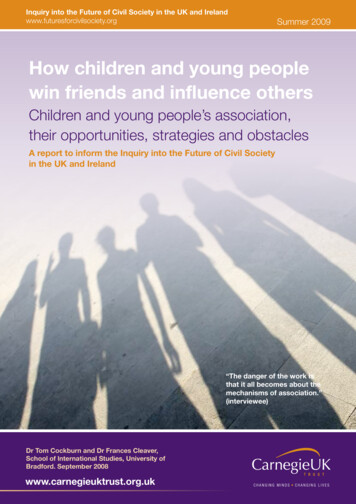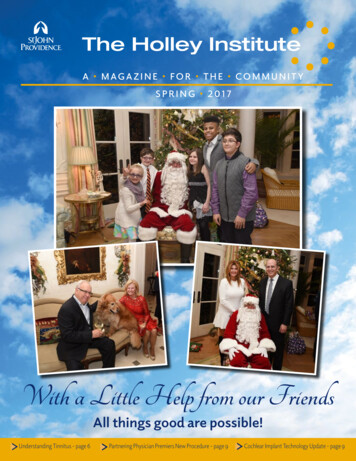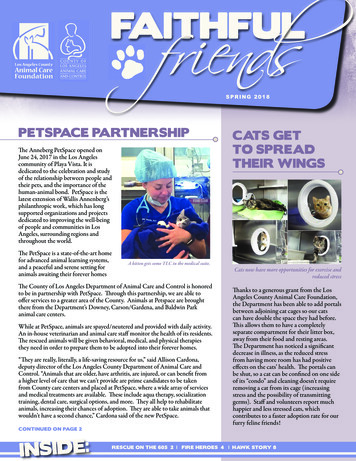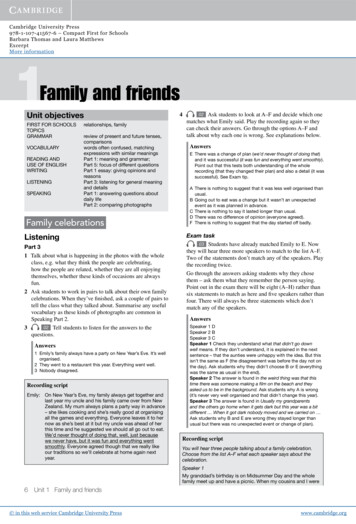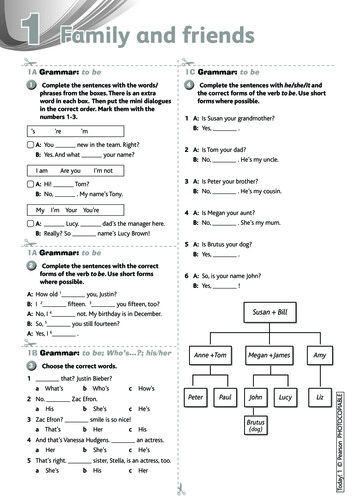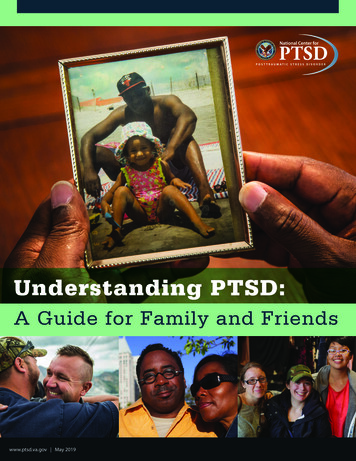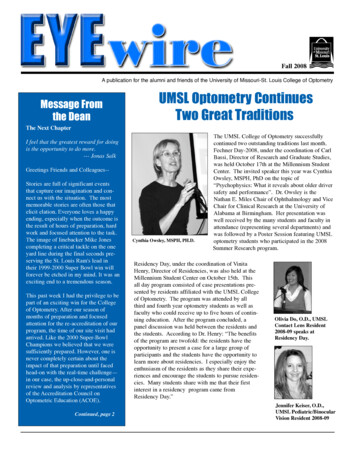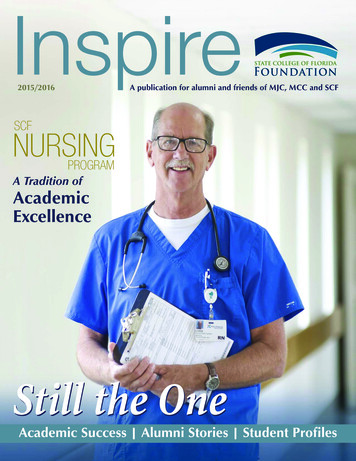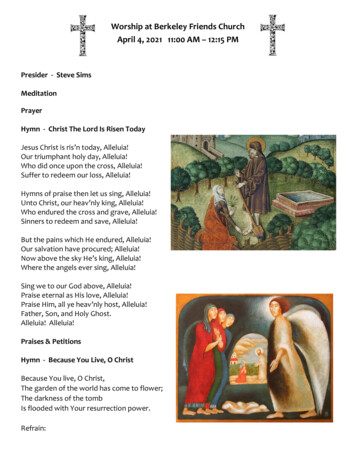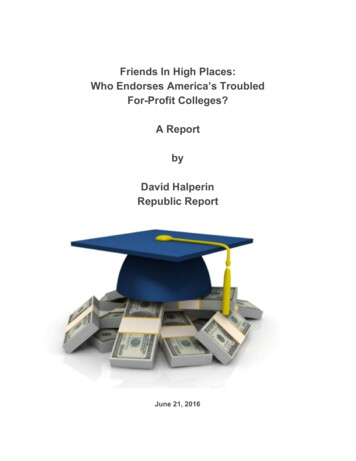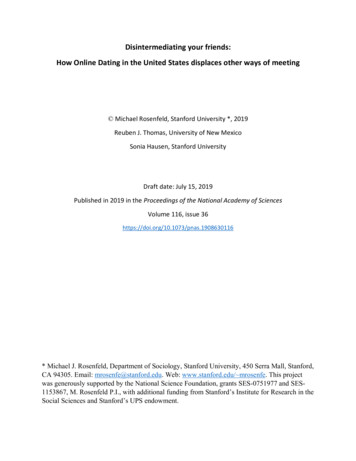
Transcription
Disintermediating your friends:How Online Dating in the United States displaces other ways of meeting Michael Rosenfeld, Stanford University *, 2019Reuben J. Thomas, University of New MexicoSonia Hausen, Stanford UniversityDraft date: July 15, 2019Published in 2019 in the Proceedings of the National Academy of SciencesVolume 116, issue 36https://doi.org/10.1073/pnas.1908630116* Michael J. Rosenfeld, Department of Sociology, Stanford University, 450 Serra Mall, Stanford,CA 94305. Email: mrosenfe@stanford.edu. Web: www.stanford.edu/ mrosenfe. This projectwas generously supported by the National Science Foundation, grants SES-0751977 and SES1153867, M. Rosenfeld P.I., with additional funding from Stanford’s Institute for Research in theSocial Sciences and Stanford’s UPS endowment.
Abstract:We present new data from a nationally representative 2017 survey of American adults. Forheterosexual couples in the U.S., meeting online has become the most popular way couples meet,eclipsing meeting through friends for the first time around 2013. Moreover, among the couples whomeet online, the proportion who have met through the mediation of third persons has declined overtime. We find that Internet meeting is displacing the roles that family and friends once played inbringing couples together.
Disintermediating your friendsFrom the end of World War II until 2013, the most popular way heterosexual Americans mettheir romantic partners was through the intermediation of friends. One’s close friends and family have,probably since the beginning of time, been the essential network foci that enable connections to otherpeople, i.e. the friends of one’s friends (Feld 1981). More distant ties have the potential to create abridge to a new, previously unknown network of people and information (Granovetter 1973). Friends,the close and the not‐so‐close, have been historically a crucial source of connections to others. The riseof the Internet has allowed individuals in the dating market to disintermediate their friends, i.e. to meetromantic partners without the personal intermediation of their friends and family.Rosenfeld and Thomas (2012) with data from 2009 showed that the percentage of heterosexualcouples who met online had risen from 0% for couples who met before 1995 to about 22% for coupleswho met in 2009. In the 2009 data, Rosenfeld and Thomas showed that meeting online had grown butwas still significantly behind friends as the most prevalent way heterosexual couples met. Furthermore,the 2009 data appeared to show that the rate of meeting online had plateaued for heterosexuals ataround 22%. In this paper we present new data from a nationally representative 2017 survey showingthat meeting online has continued to grow for heterosexual couples, and meeting through friends hascontinued its sharp decline. As a result of the continued rise of meeting online and the decline ofmeeting through friends, online has become the most popular way heterosexual couples in the U.S.meet.1It was not inevitable that the percentage of heterosexual couples who met online would havecontinued to grow beyond the previously documented 2005‐2009 plateau. Unlike gays and lesbians,heterosexuals can assume that most people they meet are heterosexuals also. Heterosexuals, becausethey constitute the large majority of adults, are usually in thick dating markets, where several potentialpartners are identifiable. The theorized advantage of face‐to‐face contact (Turkle 2015) could havelimited the growth of online dating.The traditional system of dating, mediated by friends and family, has long been theorized to beoptimal for mate selection. The family system is historically predicated, in part, on catalyzing andpromoting the most socially acceptable mating outcomes for the younger generation (Rosenfeld 2007).Meeting through friends and family provided guarantees that any potential partner had been personallyvetted and vouched for by trusted alters. Classic work by Bott (1957) found that social closure hadbenefits in terms of relationship quality and duration.1Our functional definition of couples includes married couples, unmarried couples who have cohabited, andunmarried romantic unions who have never cohabited. The substantive results are the same if we limit the analysisto only the first, or the first and second categories of couples, see SI appendix Figures S3, S4, and S5. By‘heterosexual couples’ we mean male respondents partnered with females, and female respondents partneredwith males, without regard for the sexual identity of the respondents. Heterosexuality here is the public facing,rather than the private identity.Online meeting displaces friends1
Despite the traditional advantages of meeting face‐to‐face through connections established byfriends and family, the potential technological benefits of online dating are numerous as well (Cacioppoet al. 2013; Rosenfeld 2017), and are described below. Our Hypothesis 1 is that the percentage ofheterosexual couples meeting online will have continued to grow beyond the previously identified 2005‐2009 plateau of 22%.Research on communication technology’s impact on social relations finds that technology ismore likely to change the efficiency of interactions than to change who interacts with whom (Katz1997). The broad dissemination of land line telephones in the US in the early 20th century, made it easierfor Americans to stay in touch with relatives from out of town, but it did not change who interacted withwhom. Most telephone calls were made to people one already knew (Fischer 1994).If communication technology reinforces and complements existing face‐to‐face social networks,hierarchies, and patterns (Castells 2000; Calhoun 1998; Putnam 2000), then we would expect any rise inInternet dating to reinforce rather than to displace the traditional roles of friends and family asintroducers and intermediaries. Online social networks like Facebook allow friends and family to do(more efficiently) what friends and family have always done: facilitate (potentially romantic) direct tiesbetween people who are already connected to the same social network. Even infrequently seen friendscan be easily introduced to each other online. Research on technology as reinforcing existing face‐to‐face social ties leads to our Hypothesis 2: Any rise in Internet dating will reinforce rather than displacethe intermediary roles of friends and family.There are many critics of Internet dating and Computer Mediated Communication (CMC) moregenerally. Some scholars view CMC as hollowing out our social well‐being by substituting attention‐seeking devices for more rewarding face‐to‐face interaction (Turkle 2015). If CMC depersonalizes socialinteraction compared to face‐to‐face interaction, we might expect people who date online tocompensate by leveraging suggestions from friends or family, or leveraging their Facebook network tofind friends of friends, as some phone dating apps are designed to do.2Whereas family and friends are the most trusted social relations, Internet dating and hookupapps such as Tinder, Match.Com, and eHarmony are owned by faceless corporations.3 Why mightindividuals increasingly rely on matches suggested by Tinder or Match.Com (Hypothesis 1), and whymight any increase in Online dating displace rather than amplify the role of dating tips from one’smother,4 friend, or one’s friend’s friend (contrary to the expectations of Hypothesis 2)?There are several potential reasons why the ascendency of Internet dating might displacefriends and family, despite the expectations of Hypothesis 2. First, the sets of people connected toTinder, Match, and eHarmony are larger than the sets of people connected to one’s mother or friend.Larger choice sets are valuable to everyone engaged in search (Rosenfeld 2017). Larger choice sets areespecially valuable for people who are searching for something unusual or hard‐to‐find, which is why2Phone dating apps Badoo, Hinge, and Down connect to Facebook and offer matches of friends, or friends offriends.3Tinder and Match, two of the most popular online dating platforms, are subsidiaries of the same corporateparent, Match Group, which is majority owned by IAC.4Personal mediation for dating is heavily gendered, as is most social interaction. Mothers introduce far morecouples than fathers do (Falcon 2015).Online meeting displaces friends2
online dating is even more valuable for gays and lesbians than it is for heterosexuals (Rosenfeld andThomas 2012).Second, individuals might not want to share their dating preferences and activities with theirmother or with their friends. Active brokerage of romantic partnerships by a family member or friendwould depend on the broker knowing what both individuals desire in a partner. Taking advantage ofFacebook to find friends of friends for romantic matches (i.e. passive brokerage by friends) might exposedating habits and choices to too broad an audience. Dating perfect strangers encountered online ispotentially more discreet than dating a friend’s friend.A corollary to the discretion inherent in online dating is that the online precursor to face‐to‐facemeeting inserts a layer of physical distance that can have benefits for safety. Messaging starts throughthe phone app. If the other person sends a text or a picture that is rude or inappropriate, the rudemessage sender can be blocked within the app and they have no recourse to overcome the block. Theability to block people within the apps is useful to anyone who might feel physically vulnerable meetinga stranger face‐to‐face (Rosenfeld 2018). Once the face‐to‐face meeting has taken place, the securityadvantage of the phone apps largely dissipates. It is difficult to block the person sitting next to you atthe bar, or to permanently extricate oneself from encounters with a friend’s friend. Asynchronous CMCgives people the time and distance to frame questions and answers more carefully, to find communitiesof interest outside the immediate vicinity, and to share things that might be awkward to share in person(Walther 1996; McKenna, Green and Gleason 2002).Third, Tinder, eHarmony, Match and the other Internet dating sites are in the business of havingup‐to‐date information about the people in the dating pool. Mothers and friends may have usefulinformation about a small set of individuals in the dating pool, but how up‐to‐date is the information?The architecture and ubiquity of the Internet make it easier for Match.com to have up‐to‐dateinformation on 10 million people, than for a mother or friend to have up‐do‐date information on 20people.Fourth, the online dating sites have the potential to improve their matching algorithms throughdata analysis, experiments, and machine learning over time (Wells 2018; Markowitz 2018). In anybusiness where matching is a core function, the quality of the matching algorithms are vital for thesuccess of the business. Netflix has improved its various algorithms for matching people to movies overtime (Gomez‐Uribe and Hunt 2015). Compared to the one‐way matching problem of matching people tomovies, the problem of matching people to each other is a more difficult two‐way matching problem.While there are reasons to be skeptical of the claims that the online dating sites make about thescientific nature of their various matching algorithms (Finkel et al. 2012), the online dating sites have atleast the potential for technological advancement, whereas the face‐to‐face network of friends is a morestatic technology.Graphical web browsers (introduced around 1995) and smart phones (introduced around 2007)both opened up new markets for internet dating. In the case of smart phones there were two separatebenefits. The first was location‐aware apps (such as Grindr for gay men) that could suggest matches inone’s immediate area. The second benefit of smart phones was to bring the dating app off the user’sdesktop and into their pocket, making dating accessible everywhere and at all times. The legacy InternetOnline meeting displaces friends3
dating sites that predated the smart phone era eventually added phone app versions to make theirservices available on smart phones as well as on personal computers.5The information on Match, Tinder, and eHarmony about the individuals one is interested incould be misleading, of course. Stories abound of online dating scuttled by out‐of‐date profile photos,misleading relationship statuses, and overly generous self‐descriptions (Slater 2013). It is not clear,however, that false representations are any more common in online dating than they were in the pre‐Internet era (Hancock, Toma and Ellison 2007).[Figure 1 here]Results:Figure 1 shows updated smoothed graphs (using data from both the How Couples Meet andStay Together surveys, hereafter HCMST 2009 and HCMST 2017) of how couples have met by the year offirst meeting for heterosexual couples. Same‐sex couples (not shown) were early adopters of Internetservices for meeting partners. About 65% of same‐sex couples who met in 2017 met online, comparedto about 39% for heterosexual couples. The 65% of recently formed same‐sex couples who met online isvery similar to what Rosenfeld and Thomas (2012; Figure 1) reported for same‐sex couples in 2009 usingthe 2009 data alone. As the pattern for same‐sex couples has not changed as much, we focus here onthe changes in how heterosexual couples have met since 2009.The most traditional ways of meeting for heterosexual couples, i.e. meeting through family,meeting through church, meeting in the neighborhood, and meeting in primary or secondary school,have all been declining sharply since 1940.The timing of the rapid rise of heterosexual couples meeting online in Figure 1 corresponds toboth of the important technological innovations that helped to spur online dating: the introduction ofthe graphical web around 1995, and the introduction and widespread adoption of smart phones after2007. The first technological i
that meeting online has continued to grow for heterosexual couples, and meeting through friends has continued its sharp decline. As a result of the continued rise of meeting online and the decline of meeting through friends, online has become the most popular way heterosexual couples in the U.S. meet.File Size: 307KBPage Count: 17
